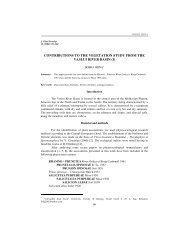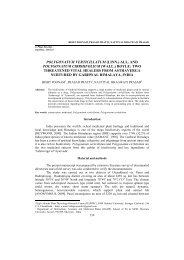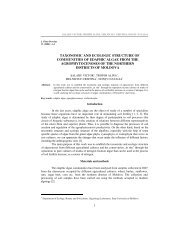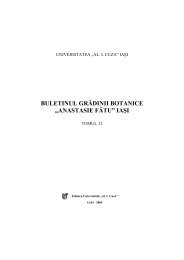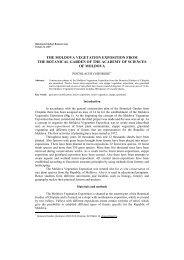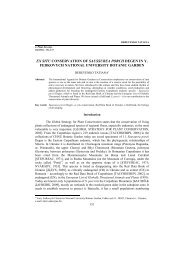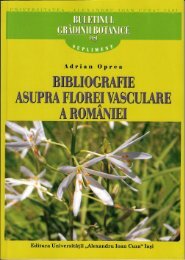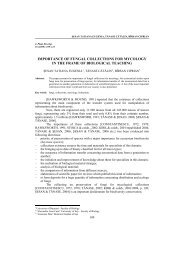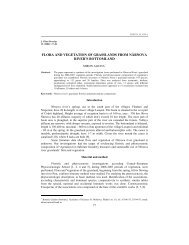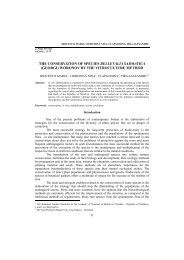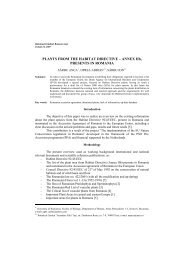trichoderma viride pers. - Journal of Plant Development
trichoderma viride pers. - Journal of Plant Development
trichoderma viride pers. - Journal of Plant Development
You also want an ePaper? Increase the reach of your titles
YUMPU automatically turns print PDFs into web optimized ePapers that Google loves.
TRICHODERMA VIRIDE PERS. – EXPERIMENTAL MODEL FOR BIOLOGICAL AND …<br />
The objectives <strong>of</strong> the research were the following: 1 – Characterization <strong>of</strong> the<br />
biologically active T. <strong>viride</strong> isolates, establishing and verifying <strong>of</strong> their biological<br />
thresholds; 2 – Evaluation and experimental verifying <strong>of</strong> the mass multiplication ability <strong>of</strong><br />
antagonistic T. <strong>viride</strong> fungi on the culture media in order to select the optimum industrial<br />
culture substrate (medium); 3 – Biochemical characterization <strong>of</strong> T. <strong>viride</strong> isolates by<br />
electrophoretic analysis <strong>of</strong> their protein pr<strong>of</strong>ile; 4 – Evaluation <strong>of</strong> the biological activity <strong>of</strong><br />
T. <strong>viride</strong> isolates against phytopathogenic fungi with high practical importance; 5 –<br />
Processing <strong>of</strong> technological phases for obtaining plant protection products based on<br />
biologically active isolates <strong>of</strong> T. <strong>viride</strong>.<br />
Material and methods<br />
As biological material there were used 5 isolates <strong>of</strong> T. <strong>viride</strong> (Td 5 , Td 35 , Td 45 ,<br />
Td 49 ,Td 50 ) and isolates <strong>of</strong> the following 8 phytopathogenic fungi: Fusarium graminearum<br />
Schwabe (T. Gibberella zeae (Schwein.) Petch), F. culmorum (W. G. Sm.) Sacc., Pythium<br />
ultimum Trow, Botrytis cinerea Pers., Sclerotinia sclerotiorum (Lib.) de Bary, Alternaria<br />
spp. [A. alternata (Fr.) Keissl., Alternaria radicina Meier, Drechsler and E. D. Eddy<br />
(Stemphylium radicinum (Meier, Drechsler and E. D. Eddy) Neerg.), all cultures obtained,<br />
isolated and preserved by the first author.<br />
1. For the characterization <strong>of</strong> the biologically active T. <strong>viride</strong> isolates, 7<br />
different solid culture media (Fig. 1), 17 sources <strong>of</strong> carbon (Fig. 2) and 18 <strong>of</strong> nitrogen<br />
(Figs. 3-4), 16 initial pH values <strong>of</strong> culture media (Fig. 5), 19 temperatures have been<br />
performed (Fig.6).<br />
Fungal growth have been evaluated by measuring the colony diameter (3-5<br />
replicates/variant) every day and using for graphs the data after 2 and 6 days. The last day <strong>of</strong><br />
experiment, the 6 th day, was the day when the T. <strong>viride</strong> colony covered the whole surface <strong>of</strong> the<br />
Petri plate <strong>of</strong> 10 cm diameter. The sporulation <strong>of</strong> tested fungus was appreciated by<br />
macroscopical analysis following the microscopical analysis [3, 22, 23, 24, 26, 27, 28, 29, 31].<br />
2. For selecting the optimum submerged culture medium, there were tested 9<br />
media containing intermediate products or residual ones from the food industry (Fig. 7) and<br />
and 4 liquid media (a-d) (tables 1-3) [25, 26, 27, 28, 29, 31].<br />
3. For the biochemical characterization <strong>of</strong> T. <strong>viride</strong> isolates the SDS-PAGE<br />
analysis was used to reveal protein bands and to determine protein molecular mass.<br />
Investigations have been performed by Laemmli vertical method, in MINI-PROTEAN II<br />
(BIO-RAD), using poliacrylamide gel as a migration substrate [5].<br />
4. For the appreciation <strong>of</strong> biological activity <strong>of</strong> T. <strong>viride</strong> isolates it was used the<br />
method <strong>of</strong> dual cultures [12]. Evaluation <strong>of</strong> antagonistic activity <strong>of</strong> T. <strong>viride</strong> isolates has<br />
been done by calculating <strong>of</strong> x coefficient from the ratio between inner radius (i) and outer<br />
radius (e) <strong>of</strong> the phytopathogenic test-fungi (A) and the antagonistic ones (B) (T. <strong>viride</strong>),<br />
after the formula X = iA/iB x eB/eA. When x=1, there is no influence between two fungi;<br />
when x1, the tested isolate prove no antagonism [31].<br />
5. Biotechnological parameters for production <strong>of</strong> the bioproducts based on T.<br />
<strong>viride</strong> strain was followed according to the general literature for microbial plant protection<br />
products’ biosynthesis and formulation [8, 13, 14, 18, 21, 32, 33].<br />
50



